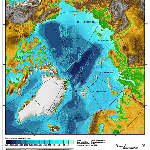Pitch
Proposes minor adjustments to the terraform of the Arctic ocean, its impact would have significant economic and environmental benefits
Description
Summary
The Arctic has in geological time not always had the same form as today. Key changes could revert it back to what it was.
As temperatures begin to rise the Greenland ice sheet will begin to melt. The Greenland ice sheet contains 2,850,000 cubic kms of ice. That will be a significant amount of cold water being dumped into the sea. It's enough cold water to raise the world's oceans 7m. However, it will not distribute evenly. Fresh water doesn't quickly mix with salt water. The rest of the oceans are denser, and warmer. That denser water is not going to give way easily.
As a result the melt will be blocked from going south. The cold water would flow towards the Arctic first. The immediate effect of that will be to cool it. 2.8 million cubic kms of cold water will flow into a place with shallow sea beds. The total volume of the Arctic ocean is 18,750,000 cubic kms. That is a replenishment of 15%. In a lake cold water goes to the bottom (called the hypolimnion). In terms of the methane deposits that is where it is needed most. The sea beds are shallow and without an ice cover the water will begin to heat up. However, fresh water freezes at a higher temperature than does salt water.
The ocean current called the Thermohaline circulation (THC) brings warm water up from the tropics. It is the reason why England does not experience the temperatures of Siberia. Some of this dense warm water continues North into the Arctic ocean through the Fram Strait with dangerous consequences for the sub-sea methane deposits.
2 changes are required to promote negative feedbacks to Arctic warming.
The warm water Atlantic flow into the Arctic can be throttled through the creation of an artificial reef in the Fram Strait.
The Bering Strait can be blocked by a sea wall. That would stop the ice pack from exiting during winter and stop the warm Pacific ocean from entering in summer.
The changes required are in fact minor, but the negative feedbacks on Arctic warming would be significant.
Category of the action
Geoengineering
What actions do you propose?
Who will take these actions?
Where will these actions be taken?
What are other key benefits?
Stabilization of the sub-sea methane through a cooling of the Arctic ocean
Atmospheric carbon sequestration. Once the Arctic ocean received enough fresh water Azolla could be used to sequester carbon on a significant scale
A restoration of the polar vortex. As the temperature differential increases via a decrease in the Arctic temperature the polar vortex would again contract to the North.
The generation of significant quantities of clean hydroelectric energy from the Bering Strait sea wall
The generation of significant quantities of clean biogas energy from the harvesting of Azolla
A potential new food source for millions of people.
Wildlife preservation through the establishment of a protected ocean area in an area away from Oxygen Minimum Zones.
Economic benefits from an artificial reef.
Economic benefits through trade between the US and Russia. A significant reduction of energy consumed in the bilateral trade.
What are the proposal’s costs?
Estimating actual cost would require input from multiple expertise domains and so is beyond my ability.
Dr Wadhams has estimated the cost to the global economy of $60 trillion dollars if nothing is done.
A dam would not have to be built across the entire Bering Strait, most of could be a sea wall. The 3 Gorges dam cost $28 billion to build. It would however, generate significant income from hydroelectricity. The initial cost of an underwater tunnel between Russia and the US was $100 billion, but it would seem a sea wall would be significantly cheaper than a tunnel. At the time of those estimates the financial return was estimated at $11 billion per year for just freight movements.
The artificial reef would preferably be built with derelict metal, so the costs would be in towing or barging the material to a suitable location in Ireland. At that point any pollutants would have to be cleaned and that waste disposed of appropriately.
